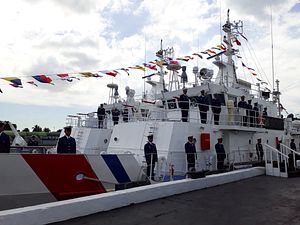Last week, Philippine President Rodrigo Duterte finally officially confirmed the appointment of a new chief for the Philippines Coast Guard (PCG). The appointment fills a position that has been left vacant for quite a while and comes as the Southeast Asian state continues to face a range of daunting challenges in the maritime space.
As I have noted before in these pages, though the Philippines, like some of its other neighboring Southeast Asian states, has been placing an increasing emphasis on the development of its coast guard, its overall capabilities still remain quite limited to cover 7,000 islands with a tenth of the world’s coastline. Indeed, despite some boosts in its levels of funding, personnel, and equipment from both internal capacity-building as well as help from external partners like Japan and the United States over the past few years, questions had remained about the future outlook of the PCG in the context of overall military modernization under President Rodrigo Duterte (See: “Where is the Philippines Coast Guard in its Military Modernization?”).
Within this broader context, the PCG has continued to confront its own internal challenges as well, whether they be related to technology or manpower. One particularly damaging incident for the service was when its previous chief, Rear Admiral William Melad, along with his predecessor Rodolfo Isorena, were among the 25 current and former PCG officers to be indicted last July for the alleged unlawful procurement of 68 million pesos worth of office supplies. The incident had led to his suspension in December 2016, following which Transportation Secretary Arthur Tugade appointed Joel Garcia as officer-in-charge pending the appointment of a new PCG chief. Since then, the PCG has been left without an actual appointed chief.
On January 4, Duterte finally signed off on papers appointing Elson Hermogino as the new PCG chief. The appointment came as Duterte also approved the appointment of three other PCG Rear Admirals: Garcia, along with Rolando D. Legaspi — Commander of the Marine Environmental Protection Command (MEPCOM) and Acting Commander of the Coast Guard District National Capital Region-Central Luzon — and Leopoldo Laroya, the Commander of Maritime Security and Law Enforcement Command.
Hermogiono, part of the Class of 1985 of the Philippine Militay Academy, has previously worked in several different capacities within the PCG within various Philippine districts and major units such as MEPCOM and the Maritime Safety Services Command, his last post which he had held since a round of reshuffling of posts that occurred in early 2015 before Duterte took office.
Hermogiono’s appointment is no doubt significant. At the most basic level, it at the very least fills a position that had been left vacant for quite a while in the Philippines’ chief maritime law enforcement service as the country continues to confront a range of important maritime issues.
But it also comes just as Duterte and his team begin to make inroads on broader military modernization after some of the broad outlines have been laid out on funding allocations and capability priorities. Ongoing developments in the Philippines’ security outlook include a greater emphasis on the Sulu-Sulawesi Seas, continued challenges in the South China Sea, as well as the counterterrorism threat that was clearly visible during the siege of the southern city of Marawi by Islamic State-linked militants last year (See: “ASEAN’s Post-Marawi Islamic State Challenge”). As these trends evolve, Hermogino’s time at the helm will no doubt be an interesting one to watch.

































